
Flavor Notes by Robert Rich: Food, Wine, Restaurants & Recipes
Recipes from the Stanford Insulin Resistance Study
A Cookbook Journal Started December 18, 2007
by Robert Rich
(updated occasionally as time permits.)
Introduction
Like many people in their mid-forties, I have been experiencing that frustrating slow weight gain that some call inevitable. In my case, I think I know the cause. I love to cook, I love to eat. Among my favorite activities I count sitting around the table with friends, chatting late into the evening around a good bottle of wine and some delightful food to nibble, like strong runny French cheeses and fresh sourdough bread. So perhaps it’s no wonder that I slowly gained about 40 pounds over the last eight years.
My wife noticed an item in the local newspaper about a study at Stanford Hospital on insulin resistance, which sought healthy subjects who were slightly overweight. The benefits included full metabolic lab tests and regular consultations with a dietician. In return they required some tissue samples, various other tests and 3-4 months adherence to a strict diet plan (or a drug protocol for the other group.) As I hadn’t seen a doctor for a full physical in decades, this looked like a good opportunity for self-evaluation.
I got accepted to the study as a control, happy to learn that I had little risk of diabetes in my future. They assigned me to the weight loss protocol, which meant I had to lose 1-2 pounds per week for three months.
The diet imposes a balance among carbohydrates, proteins and fats that previous studies show works well in reducing insulin resistance. In terms of caloric contribution, the suggested ratio is 40% Carbohydrates, 45% Fats, and 15% Protein. This is very different from the trendy “Low Carb” diets that suggest high amounts of protein. As I read it, it comes closer to a traditional Asian diet pattern.
The diet uses a point system that assigns a weight to each nutritional category. Green and leafy vegetables are free, and people should eat as much as those as possible. The other categories get counted one point as follows:
1 Carbohydrate (CHO) = 15 grams
1 Protein (PRO) = 7 grams
1 Fat = 5 grams
One point equals a portion. Note that these aren’t the total weights of the foods, but rather the weight of the nutritional ingredients within the foods. In many cases, water and indigestible fiber account for much of the mass of fruits and vegetables, so we can eat larger portions of those items than of the more concentrated foods. On the other hand, an ingredient like olive oil – while healthy and worthwhile in our diet - is almost 100% fat, so a mere tablespoon counts as 3 portions!
To offer some more examples (remembering that 1 oz. = 28 grams)
A 15 gram portion of carbohydrate (1 point)
= about 1 oz. of bread, a thin slice
= about 8 oz. of butternut squash, about 1/2 cup
= about 4 oz. of fresh apple (2/3 of an apple)
= about 1/2 cup cooked beans (garbanzo, pinto, lentils, etc.)
A 7 gram portion of protein (1 point)
= 1 oz. of very lean meat or fish (with less than 2 grams of fat.)
= 2 oz. low fat "light" tofu
As an example of the study’s recommended ratios, my specific plan specifies the following portions for an 1800 calorie daily diet:
10 Carbohydrate portions
7 Protein portions
12 Unsaturated Fat portions
Add to this at least two cups of “free” vegetables such as salad greens, broccoli, asparagus, cabbage, green beans, zucchini, eggplant, etc. Other “free” items include coffee and tea, soy sauce, vinegar, lemon juice and similar low-cal flavorings.
You could imagine the challenge such a diet might place upon a person who prefers to cook by flavor and fragrance rather than gram scale and chemical analysis. I hate to measure when I cook. I had to figure out a way to turn this diet into a project with more interesting goals than mere weight loss. For me, that means trying to come up with new and interesting dishes that fill these potentially austere requirements.
So, here are some attempts to make flavorful and filling meals while trying to keep track of the parameters of a rather disciplined insulin-healthy calorie-restricted diet. These recipes appear chronologically, as I come up with them day by day throughout the study. As I experiment, I might go back to earlier attempts to suggest improvements or change serving sizes. This is a living cookbook, a work in progress.
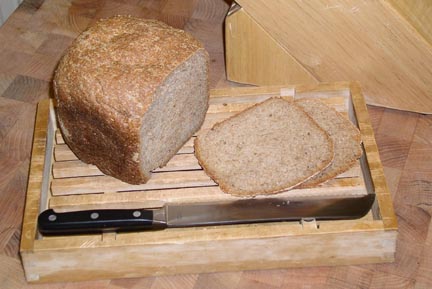
(Breakfast, lunch sandwiches)
High Fiber Bread
Works in a bread machine, regular cycle.
1 slice = 1 Carb
One loaf makes about 12 slices.
2 cups rye flour
2 Tbsp wheat gluten
1/2 cup oat bran
1/4 cup rolled oats
1/4 cup flax meal, more bran, or 9-grain cereal
1 Tbsp honey
1 Tbsp olive oil
1 tsp salt
1 tsp bread yeast
1 tsp caraway or nigella seeds for added flavor
1 and 1/4 cup lukewarm water
By adding the gluten, you can get away with using a much higher percentage of whole grain and fiber while still getting dough that rises in a bread machine. I have found that by following a basic ratio of 2 cups whole flour (wheat, rye, oat, etc.) to 1 cup coarser ingredients (wheat, oat, or rice bran, 9 grain cereal, rolled oats, seeds, etc) along with that extra gluten, the bread usually turns out firm and dense, but not leaden or overly dry. You might need to adjust the amount of water by a tablespoon or two depending on your choice of grains. The honey helps the yeast rise, so adding a bit more makes a more porous bread. The oil helps prevent the bread from drying out after baking, so the loaf retains a fresh texture for several days after baking.
If baking this by hand, knead for about 10 minutes, let rise for two hours, gently punch down, let rise again for an hour, and bake for about an hour at 350 F.

(Dinner)
Smoked Turkey Salad with Veggies and Soy-lime Dressing
2 Carbs
5 Protein
3 Fat
This dinner salad tries to provide a filling portion of raw and lightly cooked vegetables with big savory flavors, bright colors and crunchy textures. By serving the turkey and steamed vegetables warm atop the lettuce, the result satisfies hunger a bit more than a cold salad. The purple pole beans - sometimes called Navaho beans or “trail of tears” beans - have a shape that resembles snap peas, but taste like green beans only a less grassy and a bit more waxy. They have a bright purple edible pod that fades a bit when cooked. Using an acid like lime or vinegar preserves the purple color. You can substitute green beans but the purple provides nice contrasting colors. The beans would count as a "free" food or perhaps 1/2 carb.
Ingredients for each person served:
1/2 cup shredded smoked turkey (~50 grams)
6 spears asparagus
1/2 cup purple pole beans or green beans. (8 or so pods)
3-4 large outer leaves of butter lettuce
1/8 cup crushed toasted almonds.
1 tsp sesame seeds
1/4 cup coarsley chopped cilantro
Dressing:
(enough for 6 salads)
2 Tbsp honey
1 Tbsp soy sauce
1 Tbsp Tiparos fish sauce (optional)
1 Tbsp Mirin rice wine
1 Tbsp sesame oil
3 fresh limes – juiced (about 1/2 cup juice)
For the dressing, in a ceramic or glass bowl, heat the honey in a microwave with the soy, fish sauce and rice wine for about 30 seconds. Stir to dissolve the honey. Add lime juice, and then wisk in the sesame oil just before serving.
For the vegetables, cut asparagus spears in half if necessary, remove threads from the edges of the pole bean pods and place them all in a microwave safe dish that has a tight cover. Splash a few tablespoons of the dressing over the vegetables, cover and steam in microwave for about 4 minutes, or until lightly cooked (still a bit crunchy).
In the meantime, wash and dry enough large outer leaves of butter lettuce to stack about 3 or 4 on each plate, making a broad edible bowl. Sprinkle liberally with cilantro. Stack a mound of smoked turkey in the center. Arrange the warm vegetables on the sides, drizzle with the liquid from the vegetable steaming dish, top with crushed almonds and dust with sesame seeds. Add additional soy-lime dressing if desired.
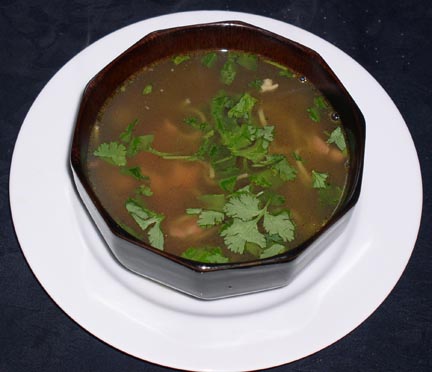
(Lunch)
Soba Noodle Soup w/ asparagus, chicken broth, turkey
2 Carbs
3 Protein
1/2 cup cooked soba noodles (Japanese buckwheat noodles)
2 cups chicken broth
1 Tbsp soy sauce
2 Tbsp Tiparos fish sauce
1 Tbsp Mae Ploy chili sauce (Thai sweet hot sauce)
2 asparagus spears, chopped small
2 Tbsp green onion (scallions) chopped fine
2 Tbsp cilantro, chopped coarse (a big pinch)
1 tsp five spice powder (clove, cinnamon, star anise, fennel seed, hua ‘do pepper)
Cook soba noodles for about 6 minutes (about 1 dime’s diameter per person) then rinse under cold water. While the noodle water is heating up in one pot, heat another pot with chicken stock, soy sauce, fish sauce, chili sauce, and 5-spice. When the stock reaches a boil, place in the asparagus and turkey. Simmer until asparagus is just softened. As the smoked turkey is already cooked, it just needs to heat up and flavor the broth. Place 1/2 cup soba noodles in each bowl, Pour in 2 cups of broth along with asparagus and turkey. Top with chopped scallions and cilantro. This also tastes great with some leaves of Thai basil and a splash of spicy Sriracha chili sauce. It’s a hybrid of pho’ style flavorings with Japanese style noodles. For a more authentic pho’ you would use rice noodles with paper thin strips of beef flank on top.
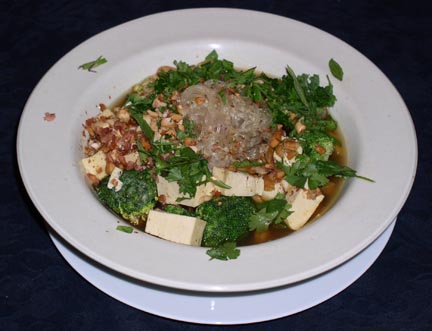
(Dinner)
Bean Thread w/ Tofu, Peanut, and Broccoli
3 Carbs
4 Protein
4 Fat
Saifun (bean threads) are made from the starch of mung beans. They turn clear and shimmery when they absorb water, with a mouth-filling slippery texture. They soak up the colors and flavors around them. Many importers offer saifun in balls resembling crackly dry birds nests, one ball per serving making about 1 cup (65 grams carb, 260 Cal.) I originally tried this recipe with one ball per person, but the resulting serving was a bit too large. For the diet plan, it’s better to split one ball in half for two people. You don’t need to boil saifun. Just soak it in hot water for 6-10 minutes to soften, then drain the water and add hot flavorful broth. The following quantities are approximately per person, and can upscale to a large pot.
1/2 cup bean threads (1/2 ball saifun)
2 cups chicken or vegetable stock (a bit less if bowls are smaller)
1/4 cup crumbled dry shiitake mushrooms
1 Tbsp dried shrimp, chopped
4 oz. firm tofu (Chinese style)
1/8 cup roasted peanuts, crushed or chopped
1 small flower of broccoli, broken into about 8 bite size chunks
1 Tbsp soy sauce
1 Tbsp fish sauce
1/2 inch fresh ginger, grated
chopped leaves of Thai basil, cilantro and parsley
Soak the dried crumbled shiitake mushrooms and chopped dried shrimp in heated chicken (or vegetable) broth for about an hour, along with the soy and fish sauce. No need to boil yet, just let the warm pot sit on the stove. Place dry saifun bean thread in each serving bowl. When mushrooms in the pot of broth are tender, bring another pot of plain water to a boil and carefully pour that hot plain water over the dry saifun in each bowl. Let stand for about 10 minutes. Drain the unflavored water off the noodles before adding the broth. This method also serves to heat up the bowls so the soup stays hot longer at the table.
To finish the broth, add the ginger and tofu to the pot and increase heat until it boils. While that’s heating up, steam the broccoli flowerettes in a covered bowl in the microwave with a splash of water and soy sauce, for about 2-3 minutes until tender but still crunchy. You can also drop the brocoli in the broth for a few minutes, but be careful not to overcook it, or the broth will take on a vegetal flavor. Arrange the broccoli on top of the saifun noodles in each bowl. Add the tofu and broth, then top with peanuts and fresh chopped leaves of cilantro, Thai basil and parsley. Serve immediately.
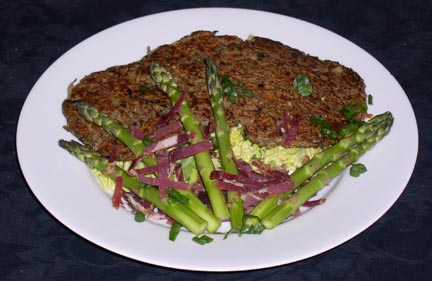
(Dinner)
Wild Mushroom Veggie Cakes with Asparagus & Prosciutto
2 Carb
3 Protein
4 Fat
The insulin study diet allows and encourages the consumption of large amounts of fresh whole “green” vegetables, and doesn’t count them among the point tally. The list includes zucchini, mushrooms, eggplant, onions and asparagus. I already consider these staples in my diet, so I wanted to come up with a dish that used these ingredients to satisfy a big appetite with minimal points; yet I wanted it to taste so good it feels a bit like cheating. Here’s an attempt that worked out very well. In fact, it’ll probably become a standard part of my repertoire.
My version used some unusual ingredients, which added to its interest. I don’t expect most people to have access to these items, so below I list more readily available substitutes. Instead of prosciutto, I actually used a deeply flavored one-year dry aged smoked lamb. The flavor is strong enough that minute amounts suffice to satisfy a meat craving. One could substitute German rauchfleisch (dry aged beef) or Serrano ham. One could also skip the meat entirely, as the veggie patties have enough flavor to play center stage in a vegetarian meal. The dried wild mushrooms in my version came from one of my own forays, the savory sweet Agaricus augustus, or Prince Agaric. I blended these with some dried shiitake in a spice grinder to make a mushroom powder. Since you can readily find bags of dried shiitake mushrooms in Asian markets, health stores or even Costco, I list only shiitake below.
This recipe serves two hungry people or three smaller appetites. The dietary points above reflect one person and half the recipe.
12 spears asparagus
15 grams prosciutto per person, thinly slivered (a few paper thin slices)
1 small zucchini
1 small eggplant (long thin types are easiest to shred, like Japanese)
1 medium onion
1 large carrot
1/2 cup powdered dried shiitake mushroom, or wild mushrooms
1/2 cup masa flour (corn flour for tortillas)
2 eggs
1/2 tsp salt
1 tsp black pepper
1 tsp ground coriander
1 tsp ground cumin
1 Tbsp light olive oil
Garnish: shredded lettuce, green onion, cilantro, balsamic vinegar or lime juice.
Using a mandolin or the julienne blade of a food processor (or lots of time and a sharp knife) grate the zucchini, eggplant, onion and carrot into very thin long confetti. With a healthy pinch of salt, toss the grated vegetables together in a bowl with your hands, let sit for a few minutes, then squeeze out excess water from the mix (compress handfuls of it over the sink if needed.) In a blender or spice grinder, make about 1/2 cup of powder from dried shiitake mushrooms, or other dried savory wild mushrooms of your choice (morels or porcini would be excellent, perhaps in slightly lower quantities due to their strong flavor.) While loosening and tossing the squeezed vegetables again with your fingers or a fork, slowly add the mushroom powder and about 1/2 cup of masa flour to the blend, getting the dry ingredients between the cracks of the damp veggies to absorb moisture. Refrigerate for about one hour. During this time, the mushrooms and corn flour will soak up more moisture and become a binder.
Crack two eggs and whisk briefly. Remove the veggie mix from the refrigerator, and blend in the eggs with a fork, fluffing the vegetable shreds to coat all the ingredients with egg. Compress the contents again with a spatula. Heat a large nonstick frying pan to medium-high, then add a bit of light olive oil, spreading it out to make a film. Taking clumps of veggie mix slightly larger than a golf ball, spread a ball of mix onto a free area of the pan with the back of a fork while smoothing the edges with a spatula. I prefer a wooden spatula for this. Cook the first side without disturbing the bottom for about 4 minutes, then quickly flip with a wide thin spatula (different from the one used to straighten the edges.) Cook the second side for 4 minutes or until golden brown. You should get about 8 cakes from the above ingredients, although vegetable sizes differ so your mileage may vary. Set cooked cakes aside on a paper towel, but serve quickly to retain the crispy exterior.
Asparagus:
While the veggie cakes are cooking, peel the tough outer layer of skin near the base from about a dozen spears of asparagus (6 spears per person.) Steam them in the microwave, in a covered wide bowl with a splash of water for 4 minutes or until cooked but still firm.
Shred some lettuce, green onions and cilantro to act as a bed. Sprinkle with balsamic vinegar, lemon or lime juice if desired. Place the veggie cakes on the bed of garnish. Place the asparagus on top, with shavings of thinly sliced prosciutto in a prominent position on top or underneath.

(Dinner)
Turkey-Shrimp Dumplings in Mushroom Miso
The dumpling filling lets you make about 30 dumplings. Serve 6 dumplings per person in two cups of mushroom miso broth, with broccoli and green onions for a very satisfying and light dinner. You can freeze the remaining cooked dumplings for future use. I specify sue gow wrappers for this recipe because they are half the thickness of wonton wrappers, but otherwise the same. This means they contribute half the carbs of wonton wrappers, but the same flavor and structure.
2 Carb
2 Protein
1 Fat
Dumpling Filling to make 30 dumplings:
1 Turkey burger patty or 150 grams ground turkey (35g protein, 5 Pro points)
2/3 cup raw cleaned small shrimp (100g by weight, 20g protein, 3 Pro points)
1/2 small sweet onion
1-2 whole scallions
1 inch cube of fresh ginger
2 Tbsp parsley
2 celery stalks (small, inner) or 1 large outer stalk
1 egg (1 Pro, 1 Fat)
1 tsp corn starch (7g carb, 1/2 point)
1/4 tsp salt
30 or so Sue Gow wrappers (thin won ton wraps, 5=15g carb, 30= 6 points)
1 egg (whisked to use as binder for the wrappers)
Mushroom Broth per person:
1/4 cup powdered shiitake
1 Tbsp red miso paste (5g carb, 1/3 point)
1 Tbsp chopped scallions
6-8 flowerettes of broccoli (spoon-size)
Start the mushroom broth an hour early – but don’t add the broccoli yet - and let stand on low heat to allow the flavors to integrate. Grind enough dry shiitake mushrooms in a spice grinder or blender, to make about 1/4 cup powder per person. In a pot with 2 cups water per person, plus an extra cup of water to allow for evaporation, add the mushroom powder and 1 tablesooon red miso paste per person. You might have to smash the miso between two spoons while blending it into the water, to break it up a bit. You’ll add the broccoli at the end, just before serving.
Bring a large pot of salted water to a light slow boil. In a food processor, add all of the ingredients for the dumpling filling, being careful to sprinkle the cornstarch widely rather than in a lump. (You could also blend the cornstarch with a tiny bit of water first to help it spread through the mix.) Pulse on low several times to get the blend started. Pause to scoop remaining bits from off the sides if needed. Then, blend on high for 30 seconds or so, until converted into a coarse paste.
Set up a large sheet of waxed paper next to the wrappers, a bowl with one whisked egg to use as glue, and the blended filling. Holding a wrapper in one hand, brush a bit of egg around one half of the edge of the wrapper with your fingertip. With a teaspoon, place a little ball of filling in the center and fold the wrapper in half around the filling, pinching slowly from the top edge around to the sides while trying to remove most of the air from inside. Too much trapped air will expand and might cause the wrapper to burst. Try to avoid putting too much filling in each dumpling. You’ll quickly learn that it squishes out the sides while folding. Usually about a teaspoon-full is right, a bit bigger than a grape.
Set the folded dumplings down on a large sheet of waxed paper until you have enough ready to start cooking. You can keep folding while cooking, but you want to be able to add each batch into the water at the same time. Prepare a draining rack next to the pot of boiling water (I use a cookie cooling rack, placed on top of a cookie sheet to catch the water.)
Slowly drop the dumplings into the gently boiling water, one or two at a time, being careful to prevent them from sticking to the bottom when they fall. Add 8 or so dumplings to the pot for each round of cooking, so the pot doesn’t get overcrowded, causing the dumplings to stick together. Cook on gentle boil for about 8 minutes. The dumplings will float to the top then get wrinkly. Fish them out when cooked with a slotted spoon, and arrange on the draining rack. Then start the next batch. Three or four rounds of cooking should complete 30 or so dumplings.
Bring the mushroom miso broth to a light boil. If you wish, you can add the excess egg from the wrapping process into the broth, to make it an “egg drop” broth. Add the broccoli and steep it in the hot broth for a few minutes. Pour the broth into bowls while portioning the broccoli, then add 6 dumplings to each bowl. Sprinkle with chopped chives, green onions, or other fresh garnish. Excellent with Sriracha sauce if you like things spicy.

Seared Ahi w/ Green Beans and Dumpling Soup
1 Carb
6 Protein
2 Fat
If you observe the sequence of recipes in this journal, you'll notice that certain ingredients repeat themselves a few times in proximity. That's because I cook at home with the ingredients at hand; and after making certain dishes, I have leftovers that might last for a few days. Then each meal turns into a challenge to re-frame the leftovers into something interesting.
I found some excellent quality frozen ahi tuna at Costco, vacuum packed in 4 oz. bags. These little pre-measured portions make excellent quick meals. I thaw a pack per person in a bath of cold water for an hour or so, then season and sear them on smoking hot cast iron for a minute or two, leaving the fish raw on the inside. This meal combines that method with a bit of stir-fried green beans and some dumplings from the freezer (see previous recipe) in a broth that flatters the tuna as well as the dumplings.
According to the diet plan, this recipe falls a bit heavy on the protein, and not enough on the carbs and fat. To solve that imbalance, you can reduce the size of the ahi, and use noodles instead of dumplings in the broth. In my case, the other foods I have in the day tend toward carb and fat (toast for breakfast, celery and carrots with peanut butter as a snack for example.) So, the weight toward protein at dinner can actually put me closer to a daily balance.
When eating this dish, I like to soak the seared ahi directly in the flavored broth to moisten it and add to its rich savory flavor.
Per Person:
4 oz. sushi grade ahi tuna
1/2 tsp Sechuan pepper corns (hua 'do)
1/4 tsp salt
1 cup green beans (a dozen or so fresh, or more if desired)
crushed garlic or shake of garlic powder
splash of soy sauce
splash of sesame oil
1 Tbsp crushed roasted peanuts
3 dumplings (see recipe above)
1 cup broth (turkey, chicken, fish, etc.)
1 Tbsp shredded fresh ginger
1 pinch Five Spice powder
1 Tbsp soy sauce
chopped green onions, chives, cilantro, etc.
This dinner is very simple. Heat a bit of turkey stock (or chicken stock, fish, etc.) with a splash of soy sauce, some shredded ginger, and pinch of five spice powder. Use the hot broth to thaw several frozen dumplings while cooking the rest of dinner. (Of, make dumplings fresh from the above recipe.) The remainder goes quickly.
Grind some Sechuan pepper corns (hua 'do) or black pepper if those are unavailable, along with half as much salt. Spinkle a pinch on both sides of the raw tuna steaks and let stand for a few minutes.
Heat a cast iron skillet or wok. Add a bit of sesame or vegetable oil, and thinly coat the wok with oil using a wooden spatula; then, toss in the green beans. Sautée on high heat for 3-4 minutes, until slight charring occurs and beans are cooked but still crunchy. Toss in garlic and a splash of soy sauce at the very end and turn off heat. These last ingredients will burn and get bitter if cooked on high heat for very long. Scoop beans out of wok or pan, onto dinner plates, and return the pan to high heat. When pan starts smoking very hot, add a new film of oil if necessary, then add the tuna. Sear tuna on all sides for about 2 minutes, until a slight char occurs but steaks are still basically raw inside.
Plate the seared ahi tuna atop the green beans and alongside the broth with dumplings. Sprinkle chopped chives, green onions or cilantro onto the broth, and sprinkle crushed roasted peanuts on the fish and beans. Serve immediately.

(Variation)
Salmon-spinach-artichoke dumplings
in turkey broth with bean sprouts and peas
I consider this recipe as a variation upon the above recipes. My intention here is to suggest that endless variations are possible from these basic healthy soups. I used the same approach above to create a bunch of dumplings to freeze and use for soups later on. For 20 dumplings I used:
1 salmon burger (raw)
1/2 cup raw shrimp
3 preserved artichoke hearts
1 cup fresh baby spinach (compressed)
1 egg
1/4 large sweet onion
3 Tbsp green onion, chopped
1 tsp corn starch
dash of salt
Follow the dumpling recipe above, with the egg wash, to make 20 or so dumplings. These will have a slightly more granular texture inside, due in part to the salmon. Flavors are more "green" and pair well with peas or greens like bok choy.
For the soup pictured, heat two cups per person of turkey or chicken broth, add a dash of soy sauce, chile flakes, salt, fish sauce, 5-spice etc. Defrost 4-5 dumplings per person in the stock (or place them in directly after cooking, at the end). Just before serving, right after the broth is boiling again, add 1/2 cup thawed or fresh peas per person and heat just until boiling again. Add 1/2 to 1 cup of bean sprouts per person and serve with dumplings.

Roasted Vegetables with 3-Bean Salad
2 Carb
1 Protein
3 Fat
Here’s a desperation meal during the busy holiday times. Today is Christmas Eve, and I know I’ll probably cheat on my diet tomorrow. In fact, I nibbled a bit today at friend’s houses, so I need make something that’s almost entirely free of points. Time to fall back on my approach to making Italian antipasti in our oven broiler, using thinly sliced zucchini, eggplant and sweet bell peppers, with a bit of olive oil and balsamic vinegar. Add a pile of three bean salad, flavor with a sprinkle of prosciutto and parmesan and call it dinner. (My wife isn’t on this diet, so she had an extra helping of cheese and crackers, and a bit of dry smoked farmer’s sausage from Dittmer’s Wursthaus to augment the antipasti.)
The best thing about this stack of vegetables, is that it tastes delicious. I know I’ll feel hungry again later, but at least my taste buds are satisfied. The roasting adds caramelized sweetness and intensifies the flavors, and the balsamic vinegar completes the circle. The pre-made three bean salad has some sugar, which augments the other flavors as the juices blend on the plate. You can easily make a good three bean salad from scratch, but that's another article.
For two people:
1 large Chinese eggplant
1 medium zucchini (or two grocery-sized small)
1-2 sweet red peppers
2 Tbsp olive oil
pinch of flavored salt (sundried tomato salt in this case)
some chopped parsley and/or fresh basil
balsamic vinegar – a drizzle
1/2 cup three bean salad per person.
Prosciutto – a few shavings
Shaved Parmesan – a sprinkle
Slice the eggplant and zucchini lengthwise into long 1/8 inch thick slices. Segment the bell peppers and remove the pith from inside, then cut into thin strips. Brush everything lightly with olive oil and sprinkle with salt. Cover one or two baking sheets with aluminum foil. Spread a thin film of olive oil on the foil. Turn on oven broiler.
Arrange vegetables on the tray(s) so that zucchini will hit the hottest spot in the broiler. Put the eggplant and peppers near the edge, or where they won’t get the full blast. Place sheets, one at a time, under very high heat about 4 inches under the broiler, until tops start to sear. Remove the first tray and insert the second (if you are using two) and watch closely, as the second will go faster. Remove the peppers from the tray, which have cooked on one side but not the other (they are better less cooked.) Turn all of the other vegetables so the uncooked sides face up, and place once more under the broiler until the other sides are just starting to blacken. Remove swiftly. Total cooking time might be 4-10 minutes maximum, depending on heat.
Place all the vegetable on a platter in a decorative manner. Sprinkle with balsamic vinegar, chopped basil or parsley and a bit of high quality coarse salt. Serve immediately with some bean salad and other light accoutrements. I like to add a small amount of strongly flavored meat (lean prosciutto for example) and a shaving of good aged parmesan cheese to augment the flavors.
If you are too hungry to treat this as a main course, it makes a very good appetizer.
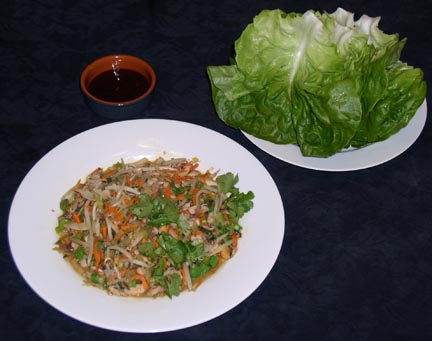
Lettuce Wrap Chicken
2 Carbs
4 Protein
2 Fat
The bulk of this meal consists of fresh, barely cooked vegetables. To make this a satisfying main course, the stir-fry should maintain a crunchy and varied texture in the mouth. That means barely cooking the vegetables. In fact much of this can remain raw if you don't mind it cold. Timing is important.
Serves 2-3 people:
1 head butter lettuce, whole leaves.
2-3 chicken thighs, boneless skinless, finely minced (4 oz. per person)
1/2 sweet onion, chopped small
6 or so fresh button mushrooms, chopped small (1-2 cups)
2-3 cups bean sprouts
1 cup sugar snap peas, chopped small
1/2 carrot, grated
1 celery stalk, finely chopped
1-2 green onions, chopped small
1/4 cups roasted peanuts, crushed
2 Tbsp hoisin sauce
1 Tbsp chinese rice cooking wine or mirin
1 Tbsp soy sauce
1 small clove garlic, crushed and minced
1 Tbsp sesame oil
1/4 cup chopped cilantro
Separate the leaves of lettuce and clean them, then set them on a clean towel to air dry while cooking. Chop the remaining ingredients and get them ready near the wok. Pre-heat the wok until smoking hot. Blend a dash of rice wine and soy sauce into a dollop of hoisin sauce, along with a bit of minced garlic, making the hoisin just runny enough to blend quickly into the stir-fry at the end.
Brush the hot wok with bit of sesame oil, then add the minced chicken. Turn swiftly for a few minutes, until mostly cooked. Add the onions and mushrooms, and sear to remove some moisture, for a few more minutes. Toss in the bean sprouts, minced pea pods, celery and shredded carrots, and stir swiftly for just a moment, to heat those ingredients but not actually to cook them. While blending the fresh vegetables, toss in the hoisin sauce mixture, and remove from heat as soon as it is blended in. Total cooking time shouldn't be more than about 5-6 minutes from start to finish.
Divide the stir-fry onto plates, and sprinkle with green onions, peanuts and cilantro before serving. Provide a small bowl of extra hoisin sauce, to smear onto a lettuce leaf before filling the leaf with stir-fry, using the lettuce as a wrapper to eat with hands.
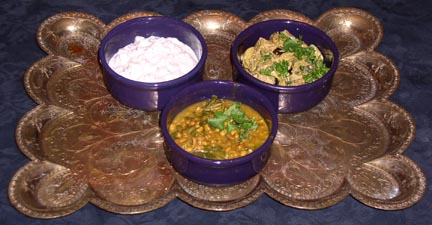
Indian Dinner with Spinach Dal, Eggplant, Raita
This meal can serve several people. To maintain the suggested calories, it’s important to serve oneself small portions. Otherwise it’s easy to overdo the carbohydrates. Although this is a vegetarian meal, some protein comes from the lentils and the yogurt. You could also add some lean lamb meatballs to the lentils for a delicious source of extra protein and flavor.
I’m presenting these three dishes together because they use several overlapping ingredients. Some ingredients – like the onion – can be cooked together for both the lentils and the eggplant, to save time. The quantities of any dish often depend upon the size of the raw ingredients used. So, rather than “one cup yogurt” and “one cup cucumber” I really seed an entire cucumber, then add yogurt to balance the quantity. Same with an eggplant – if it’s a large eggplant, I’ll use more of the other ingredients. So, as any cook would do, you should scale the following ingredients to taste. With some basmati rice, the following dishes can serve four people.
Raita:
1-2 cups nonfat yogurt
1 seeded diced cucumber
1/2 cup minced sweet onion (100g, ~1/3 onion)
1/2 cup seeded diced fresh tomatoes
1 Tbsp whole black mustard seed
salt to taste
Spinach Dal:
1 cup (200 grams) dry whole lentils
1/2 onion, thin sliced
2 cups fresh spinach leaves
2 hot chili peppers, diced (or to taste)
juice of 2 lemons (1/4 cup)
1 clove garlic
1 tsp whole cumin
2 tsp whole coriander seeds, ground fresh
1 inch cube fresh ginger, chopped
1/4 cup chopped cilantro
1 tsp black pepper
1 tsp salt
Eggplant & Mushroom Curry:
1 Chinese eggplant (200-300 grams), cubed
1 cup fresh mushrooms, quartered
1/2 onion, diced fine
1 clove garlic
2 tsp whole coriander seed, ground fresh
1 tsp chole cumin seed, ground fresh
2 dried hot peppers (to taste), ground fresh
- or - 1/4 tsp cayenne pepper
1/2 cup nonfat yogurt
salt and pepper to taste
Raita is a savory yogurt dish, which I have packed with more than the usual quantity of cucumber. Start by peeling one large cucumber, then split it lengthwise and scoop the seeds out with a spoon, discarding the seeds and gel. Mince the remaining firm portion of cucumber into small chunks. Mince about 1/2 cup of mild sweet onion. Split several small tomatoes (such as Roma) and discard the gel and seeds from inside, mincing the flesh. (Too much liquid from the cucumber and tomato seeds with water down the raita.
Heat up a dry cast iron frying pan, with a cover ready alongside. Add about 1 tablespoon of mustard seeds and cover the pan, allowing the seeds to pop and smoke a bit. Remove promptly from the heat as soon as popping slows down, so as not to burn the seeds too much. Add the seeds to a large bowl with the chopped cucumber, onion and tomato, with a dash of salt. Blend in enough nonfat plain yogurt to bind the mixture, about one or two cups. Adjust flavors with salt and black pepper to taste. Serve as a cooling condiment and salad with dinner.
Dal is the Indian word for lentils, and this version has a thick soup-like consistency with whole rather than split lentils, and fresh spinach to augment the earthy flavors. I adapted this recipe from Madhur Jaffrey, one of the best writers of Indian cookbooks. I made a few adjustments to reduce the amount of oil, and made it a bit more spicy.
Earlier in the day, take about 1 cup of whole yellow lentils, rinse a few times, then soak them in water for a few hours. Then, about an hour before active cooking time, pour off the soaking water, and add about 2 1/2 cups of fresh water to the lentils and bring to a simmer, covered. When the lentils are almost cooked, an hour later, rinse and trim about a pound of fresh spinach leaves. In a large deep pot on low heat, add a teaspoon of oil, then sweat the spinach until it wilts, for about 10 minutes. Add the spinach to the lentils and turn heat to low. Grind some whole seeds of black pepper, cumin and coriander, with some dried hot peppers if you wish, and mince one clove of garlic. Add these spices to the pot, and salt to taste. A few minutes before serving, blend in the juice of two lemons, and a handful (1/4 cup) of chopped cilantro.
Thinly slice one large onion, making ribbons from half-rings. With a tablespoon of olive oil in a large nonstick skillet, brown the onions until toasty and dark, almost burnt. Remove from the pan. Blend one half of these browned onions into the lentils, and adjust seasoning before serving. Retain the remaining onions to add to the eggplant curry.
Chop a Chinese eggplant and some large fresh mushrooms into cubes. Add a tablespoon of oil to the pan used for the onions, and bring back up to high heat. Add the eggplant and toss until browning on all sides, then add the mushrooms. When the mushrooms are cooked, add freshly ground cumin and coriander, black pepper, turmeric powder, hot peppers, one clove of minced garlic, and salt to taste. Add the remaining browned onions from the previous step. Lower the heat, and stir to blend in the spices. Now slowly add yogurt to the blend, one tablespoon at a time. Blending each bit in before adding the next. If you add all the yogurt at once, it will break up into curds with the heat.
If you want to stretch the eggplant curry to feed more people, you can add baby potatoes for a very good texture. I took about 8-10 small fingerling Yukon Golds, boiled them for about 10 minutes in salted water, and blended them in to the dish after adding the yogurt.
Together with some saffron basmati rice, the above dishes can serve four people. You can adjust individual servings to suit your needs, so dietary counts aren’t easy to predict here, but the dishes probably resolve mostly as carbohydrates, so I would guess that one cup of curry amounts to about 2-3 carbs, and maybe 1 fat.
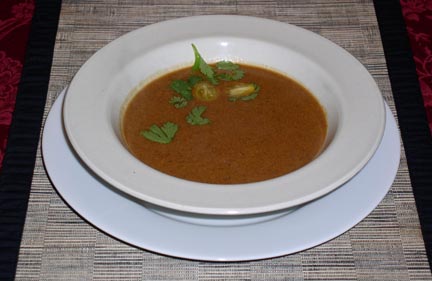
Smokey Pumpkin Soup
This recipe started from a pumpkin and black bean soup recipe that I saw during my last meeting with the nutritionist at Stanford. Unfortunately, I couldn’t find my copy of the recipe after I got home; so I decided to improvise something that suited my hankering for spicy hot flavors. This soup takes a hint from Southwest cuisine, and steers away from the typical sweet flavors more commonly paired with pumpkin, aiming instead towards tart and savory-spicy. This recipe serves about 4-5 people, about 3 cups of soup each.
2 Carb
2 Protein
1 Fat
5 cups turkey stock
15 oz. pumpkin puree (1 can – don’t use sweetened “pie filling”)
15 oz. black beans (1 can, or about 2 cups)
2 onions, diced
1-2 red sweet peppers (depends on size)
1-2 canned chipotle peppers w/ adobo sauce, minced
1 large clove garlic
2 Tbsp olive oil
2 tsp whole cumin, freshly ground
2 tsp smoked paprika (can substitute plain if unavailable)
1 tsp salt – to taste
1 tsp mace or 1/2 tsp nutmeg
1 tsp sage
1 cup nonfat yogurt (or less depending on texture)
some cilantro and fresh tomato for garnish
Dice two onions and sweat them with 2 Tbsp olive oil and a dash of salt in a deep heavy soup pot, on medium low heat, for about 30 minutes. They should be quite mushy by that time. It’s OK if they brown a bit, but stir often to make sure they don’t burn.
While the onions are sweating, use a pair of tongs to hold two whole fresh red bell peppers over a high gas flame – or place them on a grill with high flame – and allow the flame to actually burn and blacken the skin. You will hear sputtering and crackling. That’s OK. Turn every minute or less, as they scorch on each side, so the peppers get flamed evenly. Remove from flame and set aside to cool. Once you can handle the peppers, slice them open and remove the seeds and pith. Chop coarsely.
Finely dice one large garlic clove, and add the garlic to the softened onions. After a few minutes, add the turkey stock and raise the heat a bit. (Chicken stock will do in a pinch, but watch out for the salty type, and reduce salt elsewhere accordingly. I make my own without salt.) After bringing the stock up to a low boil, add a can of pumpkin puree and a can of black beans (~1 3/4 cups each). Add freshly ground cumin and sage, with some smoked paprika (if available) and a healthy pinch of mace or a bit less of nutmeg. Stir in the fire roasted chopped bell pepper.
Chop up one or two canned chipotle peppers - the type that comes wet in adobo sauce – and add the peppers with some of their sauce. These can get very spicy, so adjust quantity to your palate.
If you don’t have an immersion blender, the next step requires that you take the pot off of the heat and spoon the contents, in manageable fractions, into a food processor or blender. It’s much easier with an immersion blender, which chefs call a “giraffe”, a handheld shaft with electric propeller at the end which you can stick directly into a pot of soup.
With the pot on very low heat or removed from heat, blend the contents with the electric blender while slowly adding nonfat yogurt, one spoonful at a time, waiting a moment as each addition becomes integrated. Slowly add up to a cup of yogurt, until the soup reaches a desired creamy consistency.
Serve with a sprinkle of cilantro and chopped tomatoes, or along with a salad.
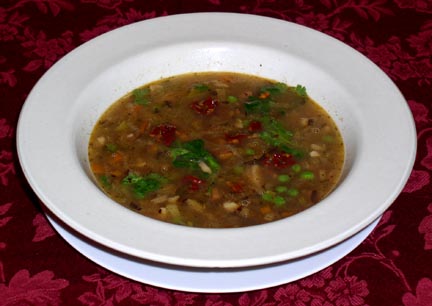
Turkey Onion Soup
In case you didn't already notice a pattern - sure, I frequently recycle ingredients when they're around in the kitchen. That's home cooking. Getting bored with soups? I am, indeed. But they also offer a filling warm wash of nutrition with low carbs and low fat. You can fill a soup with green veggies and flavor without making it an indulgence.
Like most of my cooking, this came about from ingredients around the house. I had just rendered down some turkey from the holidays, and there's always a lot of onions around. I started thinking about merging the approach of french onion soup with turkey stock, Southwest flavors and humble vegetable ingredients. The result is a rich and sweet flavored healthy soup, which you can spice up to fit your palate. With some of the smokey qualities of the chipotle, the flavors trick the palate into thinking bacon must be involved, despite low fat.
This soup is an improvisation, and it might look like it take a long time to make. Yes, an onion soup takes time. But like so much country cooking, the time isn't constant. It involves a few hours planning ahead, and a few hours staying near the stove; but if you have work to do near the kitchen, you can maintain some non-cooking productivity while keeping half an eye on the slow cooked part of the preparation.
To comment a bit on slow cooking, this recipe uses concepts from French cuisine where long cooking durations create sugars from simple ingredients, and earthy sweetness gets introduced simply from time and heat. I don't know if the sugars that come from caramilzed onions convert into carbs away from the "free" fiber that onions count on the documents I have These become complex questions. At that point, I can say I know this tastes good.
2 large onions, finely diced
2 boneless skinless chicken thighs, diced
5 cups turkey stock
1 large celerey stalk
1 large carrot stick
4-5 fresh shiitake mushrooms
1/8 cup chopped parsley
2 Tbspn olive oil
Splash of brandy or dry vermouth
1 tsp salt
1 tsp pepper
1 tsp thyme
1 tsp savory
1/4 cup chopped parsley
1 cup green peas (frozen or fresh)
squeeze of lime (per bowl)
1 Tbsp adobo with chipotle (to taste)
Prep: finely chop 2 boneless skinless thighs of chicken, and two onions. Chop the celery, carrot, shiitake mushrooms and parsley to prepare for the last steps. Thaw a cup of frozen peas (or clean a cup of fresh peas.)
Heat 5 cups of turkey stock and leave on low simmer. Heat a large deep frying pan and add 2 Tbsp olive oil. Add two thinly sliced large onions, with a pinch of salt, and sweat for 10 minutes on medium heat. Stir occasionally. Keep stirring every two minutes, and observe the texture of the onions, making sure nothing is burning. Keep heating until onions become dryer and softer, then add a scoop of hot turkey stock to re-moisten. (This is the basic technique of French onion soup.) Reduce the liquid and continue to soften the onions, with additions of stock as needed until the onions get caramalized, light brown and very soft, probably about 30 minutes. Place the softened onions into the remaining stock, then place the frying pan back on low flame.
Add chopped celery, carrots, mushrooms and parsley into the turkey stock, to simmer down and soften while doing the rest of the preparation. Combined with the onions, these make the foundation of a classical French "mirepoix." Also add some thyme, savory and black pepper to taste, roughly a teaspoon each. (Add more herbs and spices later if needed.)
When the frying pan gets hot again, put in a bit more olive oil, then add the chopped chicken, a pinch of salt, and sautée while stirring until browned on all sides. Aim for dark brown and don't worry if it gets a bit overcooked (but avoid burning) as the chicken will end up moistened in soup and you are using it mostly for the caramilized flavor. Put the chicken into the simmering pot of stock, and return the frying pan to heat once again.
Deglaze: pour a splash of brandy or dry vermouth into the hot frying pan to deglaze the sticky dark sweet crust from the bottom of the pan. Scrape the pan's crust into the simmering brew as it boils down briefly, and pour that darkened mix into the soup. This will add a deep sweet flavor.
Let stand on low heat for a while to allow flavors to integrate. Just before serving, bring up to a near boil and add the peas (these are best fresh.) For a spicy touch blend in a chopped chipotle pepper and adobo, with a squeeze of about 1/4 lime in each bowl, and some parsley/cilantro garnish. Add an additional dash of salt to taste.
The overall flavors tend toward sweet and "umame" - meaty and rich, while the spices and lime spritz bring lighter savory touches. Three cups per person feel very filling.
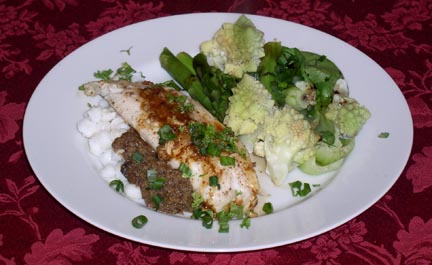
Tilapia, mushroom duxelles & winter greens
1 carb
4 protein
1 Fat
Here's a hearty tasting winter dish that weighs heavy on the vegetables and light on calories, yet satisfies cravings with earthy rich flavors.
Tilapia is a lean white fish that you can find frozen in convenient fillets around 4 oz. It doesn't have a strong flavor, but it blends well with the rich flavors of mushrooms. I made a duxelles of wild mushrooms and omitted the butter that typically accompanies a classic duxelles. (I'll explain this in a moment.) I added a small scoop of whole hominy corn for savory texture. The vegetables came fresh from the farmer's market (bok choy, asparagus and romanesco) steamed in a microwave with a bit of dry vermouth and sprinkled with balsamiic vinegar. The result was very flavorful, filling and very light.
Making a duxelles from scratch takes about an hour, so if you can't spend that sort of time, you can by "mushroom tapenade" from places like Trader Joe's, or simply sauté some mushrooms in a bit of olive oil until soft. Duxelles is a method of preserving wild mushrooms by slowly cooking out their moisture, combined with onions and a bit of salt, and blending in melted butter to help preserve and distribute the flavors. This method intensifies the mushroom flavors and creates a blend that you can freeze for long storage. To avoid the butter, this is a fresh duxelles using only a bit of olive oil. I replaced some of the sweet buttery goodness with a bit of very reduced chicken stock, boiled down into the blend.
Duxelles:
1/2 lb fresh mushrooms, finely chopped
1 onion, finely chopped
1 Tbsp oilive oil
1/2 tsp salt
1/2 cup chicken stock
black pepper to taste
(If the chicken stock is salted, omit the salt above.) Heat a large skillet on medium, spread oil onto it, then add onions and mushrooms. Stir occasionally while reducing liquid out of the blend, on medium-low heat, for 30-60 minutes. You don't need to attend it constantly, just make sure it doesn't brown too much or burn. As the blend becomes dry, add stock and salt to taste (if stock is unsalted.) Grind in some fresh pepper. Continue to reduce until flavors are very concentrated, and texture becomes somewhat homogenized. Set aside.
Vegetables:
Before starting the fish, chop up some green winter vegetables and put them in a covered ceramic dish, for the microwave. Splash with dry vermouth or white wine (or water-lemon juice mix) and microwave for a few minutes, just before serving. For this dinner I used bok choy, asparagus and romanesco. Many choices could work as accompaniment, such as spinach, brocoli, chard, etc.
Upon serving the vegetables, sprinkle them with a good balsamic vinegar, salt and pepper.
Tilapia:
1 Tilapia fillet per person
splash of dry vermouth
1 clove of garlic
1 tsp olive oil
pinch of salt, pepper, nutmeg
Heat a large heavy skillet, with a lid nearby. Finely mince a clove of garlic. Sprinkle salt and pepper over thawed tilapia fillets. Spread olive oil on skillet, and place tilapia on medium-high heat for a minute or two on one side. Flip the fish fillets carefully onto the other side, so as not to break them apart. Toss in the garlic and wait a moment to let it sear. While searing the garlic, sprinkle a tiny pinch of nutmeg or mace onto the upper side of each fillet. Now add a splash of dry vermouth (or an un-oaked white wine) to deglaze the pan and prevent the garlic from burning. Once the alcohol has evaporated out of the liquid (a minute or two) put the lid on the pan and reduce heat, to steam a moment while plating the rest of the meal.
I plated the tilapia atop a half-cup of hominy corn, a couple tablespoons of duxelles, alongside a large pile of vegetables, and with a sprinkling of parsley and green onions.
CODA
Alas, toward the end of this project, I got a bit buried in my music business: preparation for some concerts, a new album release, a new website for my music (http://robertrich.com). I had to stop writing full recipes from the study to salvage some time.
However, that doesn't mean I stopped cooking, and I continued to participate in the study. In fact I lost a total of about 20 pounds in 3 months. It takes about 30-60 minutes of actual effort to cook most of these meals, but it takes about 2-3 hours to ducument a recipe and add it to this journal. In a few cases, I did manage to take a quick photo if dinner turned out good, and I'll add them here at the end just to give some indication of the mix-and-match approach I take to cooking. You won't need recipes for these. They use variations upon ideas described above.
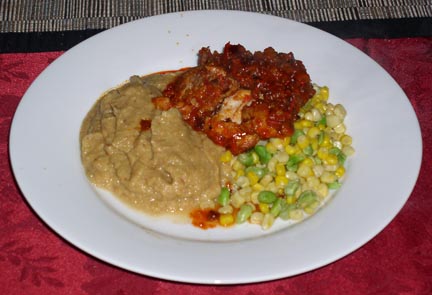
Chicken Breast, cauliflower purée, veggies
The chicken breast came raw, skinned and boned from Costco. I first dusted 4 breast fillets with flour, salt and pepper, then browned them on the outside in a heavy sauté pan with a bit of olive oil. Then I put them in a covered pan with some tomato ragu and a cup or two of red wine, chopped onions and garlic. I covered the pot and braised the contents for about one hour at 350 degrees F. The "Soycuttash" came from Trader Joe's, steamed in the microwave in a covered glass dish for 4 minutes with a splash of dry vermouth, salt and pepper. The "Smokey Cauliflour Purée" appears in a recipe above, using a head of cauliflour, an onion or two slow cooked, and a bit of chipotle in adobo. A very satisfying and filling meal with a large amount of fiber.
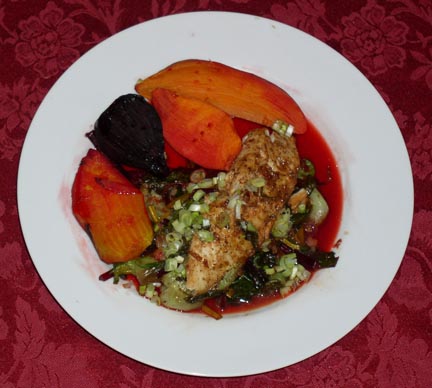
Halibut fillet on greens, beets and yam
I coated two fillets of halibut with a crust of coriander, black pepper, dry parsley and a pinch of salt. After all the vegetables were done, these got seared on very high heat with a bit of olive oil until light brown outside, moist inside. For the veggies, I cut a few red and yellow beets and one small dark yam. I steamed these in a covered glass caserol in the microwave with a splash of vermouth for about 5 minutes. The bright orange beet juices colored the reduced vermouth and become the sauce underneath. I chopped up the beet greens and sautéed them on medium heat (in the pan later used for the fish) with a drop of olive oil and a clove of chopped garlic. I added a chopped head of baby bok choi halfway through. As soon as those vegetables left the pan onto the plates, I brought the heat up to sear the fish quickly. On top I sprinkled chopped green onions as a garnish.

Turkey Meatballs with beets and potatoes
Can you tell it's winter and we're getting our root vegetables at the farmer's market? Yup, it's beets again. I have fallen in love with this colorful sweet root, especially when it's fresh. This time I used about a pound of freshly ground turkey, mixed it with an onion, a garlic clove, some salt, thyme, oregano and parsley, one egg, and formed little meatballs by working them between two soup spoons. Each meatball is about an once, or a bit less. I dropped the meatalls into salted boiling boiling water to firm them up until they floated, then placed them on foiled cookie sheets (a bit of olive oil on the aluminum foil) and placed them in a 400 degree F oven for about 30 minutes, turning them once or twice in between. The fingerling potatoes got the same treatment in the oven (at the same time) with a bit of olive oil and salt, except they went under the broiler to get nice and brown. There's some chopped Napa cabbage underneath the potatoes, and a splash of organic Red Pepper/Tomato soup from a carton purchased from Trader Joe's used as a sauce. I augmented the red pepper soup with a bit of chipotle pepper. Since the scale of a picture is hard to determine, each item on the plate in this picture is about the size of a short thick thumb.

Seared tilapia, mushrooms & onions on Ceasar salad
Topping a simple pile of chopped Romaine lettuce (tossed with a tiny dollop of Caesar dressing) with some sliced carrots and a few shreds of Parmesan cheese, a quickly seared tilapia fillet and a reduction of onion and wild mushrooms, sweated with a bit of olive oil and deglazed with a splash of dry vermouth.
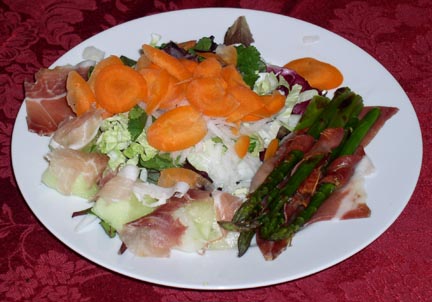
Prosciutto-wrapped Asparagus with salad
Although prosciutto has some saturated fat, it has a strong flavor so not much gets used. I like to cut it into very thin long strips and wrap it in spirals around fresh asparagus. These then go under the broiler for a few minutes until crispy (I usually turn them once halfway through. I judge by color.) This dinner included the asparagus on a salad of butter lettuce, Napa cabbage, daikon, cilantro and carrots, with a dressing of lime juice and a bit of honey. A few extra slivers of prosciutto decorated the plate like candy. Delicious.

Yet another stirfry
Baby brocoli, chicken thigh fillets thinly cut, onion, garlic, peanuts, cilantro. Start with the chicken on a hot wok, add the other ingredients tossing quickly, then splash with a bre-blended Tbsp soy sauce and rice wine, tsp of brown sugar and corn starch. Serve immediately when starch thickens, onto a bed of chopped daikon and cabbage, top with a sprinkle of chopped green onion, chive or cilantro.
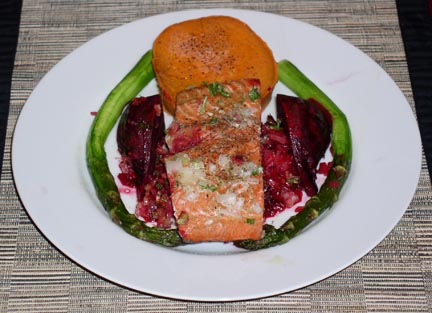
Valentine's Dinner with Salmon, Yam, Beets, Asparagus
A heart shaped delight with sweet, tart, fresh and rich flavors. Yam, beets and asparagus were cooked in the microwave (asparagus 3 minutes, root veggies about 5-6 minutes.) Wild Sockeye Salmon fillet seared with a bit of olive oil, salt, pepper. The greens from the beet heads were chopped up and sautéd with some onion, pinch of salt and splash of dry vermouth reduced at the end, with a splash of fresh lime. Chopped cilantro on top.
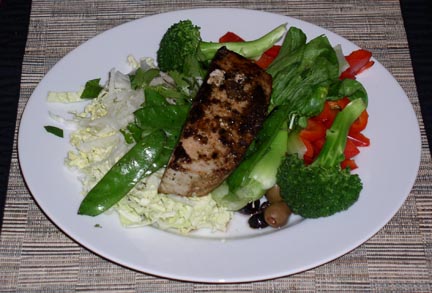
Tuna fillet with green vegetables
Yellowfin tuna fillet is seared with schezuan peppercorns, salt, black pepper on a smoking-hot cast iron skillet, then quickly reduced with a splash of balsamic vinegar and dry vermouth, removing very quickly before the sugars from the reduction start to burn. (The fish should be almost raw inside.) This goes onto a plate of chopped Napa cabbage with steamed brocoli, snow peas and raw red bell pepper. A few green and Calamata olives pull the flavors westward.
I kept returning to these dinners of fish fillet on top of greens because I found that I lost the most weight each week when eating this way. Loading the plate with green vegetables gave us plenty to fill our bellies while distracting from the lack of heavy sauces or large servings of meat. The fish satisfied our protein cravings while giving us better qualities of fat. Concerns about mercury content should moderate a diet that focuses only on ocean fish. So we mix it up as much as possible.
Writing this partial summary in late April 2008, a month after the end of the study, I have been able to keep my weight to within a few pounds of my lowest point in the study, with a bit of effort. I certainly see that it's easy to start climbing again, especially with the way I love to cook (and eat) and with the amount of social visits we get around our little homestead. However, some of the tricks I figured out above should help me in the future, as I try to avoid the inexorable climb back up in weight. Once I relax a bit from the intense part of the diet, I will work on losing another ten or so pounds, which should get me a bit closer to the weight I held at my prime! - Robert